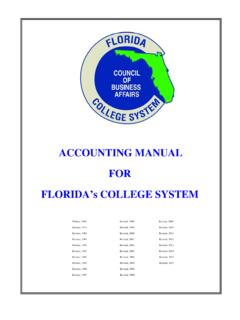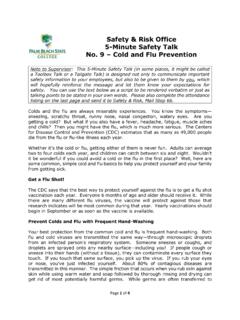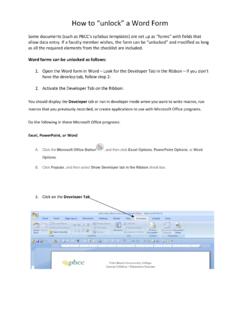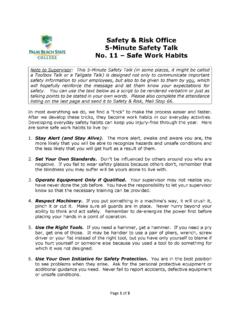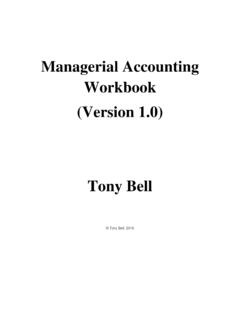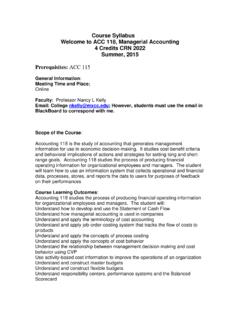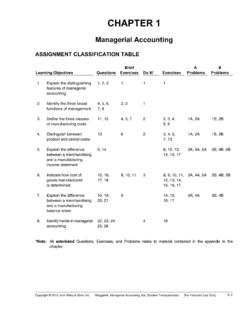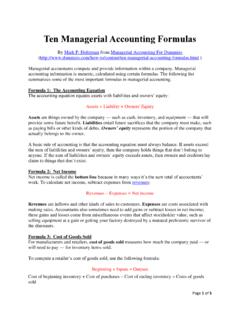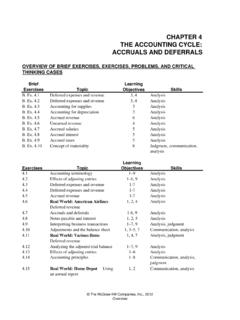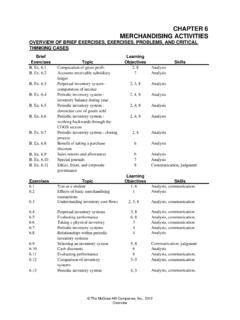Transcription of Weygandt Intermediate Accounting 9e Solutions …
1 Copyright 2014 John Wiley & Sons, Inc. Weygandt , financial Accounting , 9/e, Solutions Manual (For Instructor Use Only) 8-1 CHAPTER 8 Accounting for Receivables ASSIGNMENT CLASSIFICATION TABLE Learning Objectives Questions Brief Exercises Do It! Exercises A Problems B Problems 1. Identify the different types of receivables. 1, 2 1 2. Explain how companies recognize accounts receivable. 3 2 1, 2 1A, 6A, 7A 1B, 6B, 7B 3. Distinguish between the methods and bases companies use to value accounts receivable. 4, 5, 6, 7, 8 3, 4, 5, 6, 7 1 3, 4, 5, 6 1A, 2A, 3A, 4A, 5A 1B, 2B, 3B, 4B, 5B 4. Describe the entries to record the disposition of accounts receivable. 9, 10, 11 8 2 7, 8, 9 6A, 7A 6B, 7B 5. Compute the maturity date of and interest on notes receivable.
2 12, 13, 14, 15, 16 9, 10 3 10, 11, 12, 13 6A, 7A 6B, 7B 6. Explain how companies recognize notes receivable. 11 10, 11, 12 7A 7B 7. Describe how companies value notes receivable. 8. Describe the entries to record the disposition of notes receivable. 17 3 11, 12, 13 6A, 7A 6B, 7B 9. Explain the statement presentation and analysis of receivables. 18, 19, 20 3, 12 4 14 1A, 6A 1B, 6B 8-2 Copyright 2014 John Wiley & Sons, Inc. Weygandt , financial Accounting , 9/e, Solutions Manual (For Instructor Use Only) ASSIGNMENT CHARACTERISTICS TABLE Problem Number Description Difficulty Level Time Allotted (min.) 1A Prepare journal entries related to bad debt expense. Simple 15 20 2A Compute bad debt amounts. Moderate 20 25 3A Journalize entries to record transactions related to bad debts.
3 Moderate 20 30 4A Journalize transactions related to bad debts. Moderate 20 30 5A Journalize entries to record transactions related to bad debts. Moderate 20 30 6A Prepare entries for various notes receivable transactions. Moderate 40 50 7A Prepare entries for various receivable transactions. Complex 50 60 1B Prepare journal entries related to bad debt expense. Simple 15 20 2B Compute bad debt amounts. Moderate 20 25 3B Journalize entries to record transactions related to bad debts. Moderate 20 30 4B Journalize transactions related to bad debts. Moderate 20 30 5B Journalize entries to record transactions related to bad debts. Moderate 20 30 6B Prepare entries for various notes receivable transactions. Moderate 40 50 7B Prepare entries for various receivable transactions.
4 Complex 50 60 Copyright 2014 John Wiley & Sons, Inc. Weygandt , financial Accounting , 9/e, Solutions Manual (For Instructor Use Only) 8-3 Weygandt financial Accounting 9E CHAPTER 8 Accounting FOR RECEIVABLES Number LO BT Difficulty Time (min.) BE1 1 C Simple 1 2 BE2 2 AP Simple 5 7 BE3 3, 9 AN Simple 4 6 BE4 3 AP Simple 4 6 BE5 3 AP Simple 4 6 BE6 3 AP Simple 2 4 BE7 3 AN Simple 4 6 BE8 4 AP Simple 6 8 BE9
5 5 AP Simple 8 10 BE10 5 AP Moderate 8 10 BE11 6 AP Simple 2 4 BE12 9 AP Simple 4 6 DI1 3 AP Simple 2 4 DI2 4 AP Simple 4 6 DI3 5, 8 AP Simple 6 8 DI4 9 AN Simple 4 6 EX1 2 AP Simple 8 10 EX2 2 AP Simple 8 10 EX3 3 AN Simple 8 10 EX4 3 AN Simple 6 8 EX5
6 3 AP Simple 6 8 EX6 3 AP Simple 6 8 EX7 4 AP Simple 4 6 EX8 4 AP Simple 6 8 EX9 4 AP Simple 6 8 EX10 5, 6 AN Simple 8 10 EX11 5, 6 AN Simple 6 8 EX12 5, 6, 8 AP Moderate 10 12 EX13 5, 8 AP Simple 8 10 EX14 9 AP Simple 8 10 8-4 Copyright 2014 John Wiley & Sons, Inc.
7 Weygandt , financial Accounting , 9/e, Solutions Manual (For Instructor Use Only) Accounting FOR RECEIVABLES (Continued) BYP4 4 AP Simple 10 15 Number LO BT Difficulty Time (min.) P1A 2, 3, 9 AN Simple 15 20 P2A 3 AN Moderate 20 25 P3A 3 AN Moderate 20 30 P4A 3 AN Moderate 20 30 P5A 3 AN Moderate 20 30 P6A 2, 4, 5, 8, 9 AN Moderate 40 50 P7A 2, 4 6, 8 AP Complex 50 60 P1B 2, 3.
8 9 AN Simple 15 20 P2B 3 AN Moderate 20 25 P3B 3 AN Moderate 20 30 P4B 3 AN Moderate 20 30 P5B 3 AN Moderate 20 30 P6B 2, 4, 5, 8, 9 AN Moderate 40 50 P7B 2, 4 6, 8 AP Complex 50 60 BYP1 3 E Moderate 20 25 BYP2 9 AN, E Simple 10 15 BYP3 9 AN.
9 E Simple 10 15 BYP5 4 AN Moderate 20 30 BYP6 3 E Simple 10 15 BYP7 3 E Simple 10 15 BYP8 4 E Simple 15 20 BYP9 AP Moderate 10 15 BLOOM S TAXONOMY TABLEC orrelation Chart between Bloom s Taxonomy, Learning Objectives and End-of-Chapter Exercises and Problems Learning Objective Knowledge ComprehensionApplication Analysis Synthesis Evaluation 1.
10 Identify the different types of receivables. Q8-2 Q8-1 BE8-1 2. Explain how companies recognize accounts receivable. Q8-3 BE8-2 E8-1 E8-2 P8-7A P8-7B P8-1A P8-6A P8-1B P8-6B 3. Distinguish between the methods and bases companies use to value accounts receivable. Q8-8 Q8-4 Q8-5 Q8-6 BE8-4 BE8-5 BE8-6 DI8-1 E8-5 E8-6 Q8-7 BE8-3BE8-7E8-3 E8-4 P8-1A P8-2A P8-3A P8-4A P8-5A P8-1BP8-2BP8-3BP8-4BP8-5B 4. Describe the entries to record the disposition of accounts receivable. Q8-9 Q8-10 Q8-11 BE8-8 DI8-2 E8-7 E8-8 E8-9 P8-7A P8-7B P8-6AP8-6B 5. Compute the maturity date of and interest on notes receivable.
